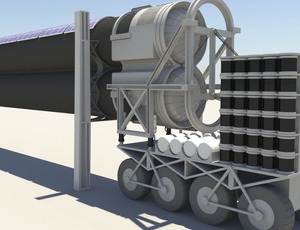

A design software leader is rethinking the construction methods and materials for Hyperloop Alpha, the high-speed mass-transit proposal that shoots passenger-filled capsules suspended on air cushions through low-pressure tubes. The new design pushes for yet-to-be-realized advances in construction and composites technology.
"We're almost obliged to check it out," says Jordan Brandt, Autodesk technology futurist, about the company's responsibility as an industry leader to weigh in on the Hyperloop proposal. "I'm a mad scientist," adds Brandt, who created the 3D cloud collaboration technology Glue that got the attention of Autodesk, which acquired both his former company, Horizontal Systems, and Brandt himself.
To get the ball rolling within Autodesk, Brandt did a rough redesign of serial entrepreneur Elon Musk's original proposal. He changed the two parallel, horizontally placed steel transit tubes to a single carbon-fiber-weave circle that is pinched into a figure eight to form two vertically stacked tubes. Brandt shared his idea with Autodesk's design experts to improve upon in Autodesk Fusion, a 3D CAD program that allows for design collaboration.
The idea of using composites such as carbon fiber for the tubes is tempting because it would extend the distance between the tube's support piers to 130 ft from 100 ft and reduce the probability of pressure loss inside the tube, says Brandt. Musk's original proposal called for steel sections to be trucked into place and joined with welds, creating hundreds of thousands of opportunities for leakage along a proposed 350-mile-long route from San Francisco to Los Angeles.
Brandt's construction method would use a rolling braiding machine to weave the tubes in place from spools of fiber material and fuse them with resin as they pass out of the braider. He says Musk's original concept was spot on with the physics but thinks some of the construction methods can be improved upon. He adds that Musk's openness at giving the idea to the public to improve is exactly what Autodesk is trying to encourage. Beyond the groundbreaking innovation required for Hyperloop, Brandt's own suggestion needs a lot of innovation to move from digital design to reality.
For example, there is no machine that can weave and manufacture a carbon-fiber pipe while rolling, and, at the current market rate of $15 to $30 a pound, carbon fiber is cost-prohibitive. But the design works, according to the recent Autodesk acquisition, Firehole Composites, Laramie, Wyo., which makes software that simulates and analyzes composite materials. Brandt says if Hyperloop gets a green light, it is just the kind of project that can spur advances in construction and composite technologies.
"A bold idea like Hyperloop can drive another material forward," Brandt says. To help make his design possible, he counts on advances from places such as the Department of Energy's Oak Ridge National Labs (ORNL), Oak Ridge, Tenn. The lab works on reducing manufacturing and materials costs for carbon-fiber precursor.
"We aim to get the cost down to $5 to $7 a pound within the next three to five years," says Amit K. Naskar, research-and-development lead of ORNL's carbon and composites group. His research is meant for the auto industry, which could replace fiberglass with cheap carbon fiber for car bodies.
"We're not saying this is the final design, but it's a suggestion," says Brandt. "We want to further Elon's idea and push for improvement." He adds that Autodesk is gauging the interest of engineers who might want to improve upon Hyperloop's design before opening up the company's designs to public input.




Post a comment to this article
Report Abusive Comment